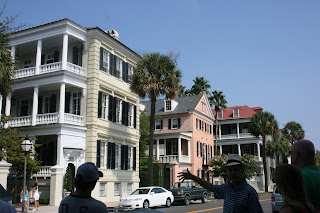To experience the most of Charleston during such a short visit, my friend and I took a Civil War walking tour (thank you, Groupons). Let me be clear...a Civil War walking tour in Charleston, South Carolina, where every member of the tour (excluding our fearless leader, Jack the Tour Guide) were born either above or outside of the proverbial Mason-Dixon line. Not controversial at all, right? You can see why light and dark play such a big part in this blog...
Charleston is a beautiful, charming city. The buildings and streets reflect the serentiy common to images and stories of the Antebellum South. Every house offered up literally picture-perfect images.
Charleston's beauty comes from its well-preserved physical history. There are no soaring skyscrapers, little modern architectural design, and many original cobblestone roads weave throughout the city center. Charleston's historical charm, however, comes from Civil War-torn devastation. With no labor force and no infrastructer, the city had no money to rise from the ashes stronger and more modern. But, it turns out, Civil War rubble brings tourists in droves. So the inability to build a "better" Charleston during Reconstruction became their saving grace.
But the light of Antebellum grandeur is always contrasted by the darkness of slavery. At the start of the tour, after laying out his credentials, Jack the Tour Guide said plainly, "So, slavery. Do we want to talk about it or not?" The shock and discomfort in the room was palpable. We all knew we needed to talk about it, but in what context? How does one celebrate Charleston's charm without denying a dark mark on America's historical narrative? How do we confront the remnants of slavery without villainizing modern-day Charleston? (Our tour meandered through fairy tale cobblestone roads, and stumbled upon):
I'm still not sure I have an answer. Jack the tour guide faced it boldly, flippantly at times, by stating practically that we must not think like 21st century Americans, but place ourselves in the minds of 19th century Charlestonians to whom slavery was a natural part of life. Jack spoke in terms of capital and business, and, perhaps, in an effort to preemptively defend against Yankee judgement, reminded us repeatedly that slavery was an American activity, not just a Southern one.
I could spend an hour relating my discomfort with the conversations we had throughout the streets of Charleston. No matter how hard I tried (I took many deep breaths and even craked a joke about out-bidding my tour companion for a slave with special barrel-making skills), I could not ignore my contemporary humanitarian views. Nor do I want to. But there is something to be said for understanding, accepting, and moving forward from a collective history which, I, as a lover of my country, embrace.
In the end, what I appreciated about the Charleston I encountered was that, like Jack the Tour Guide, it didn't cover up its past. Sharp iron spikes (which according to Jack kept intruders and revolting slaves at bay) share architectural space with cool, marble verandas and charmingly shuttered windows. Charleston presents its light and darkness side by side, lets the viewer draw their own conclusions, and perhaps learn a little bit more about their own relationship to history in the process.

Jack the Tour Guide, and his Civil War archival photography
Boone Hall Plantation
Boone Hall Plantation
Boone Hall's famous oak lane (lots of movies filmed here)
For my own sake and that of any readers, I want to state that because this is a blog, I have barey skimmed the surface of what is a deep and meaningful discussion. These are just thoughts I chose to share because this is a blog about life's joys, and I enjoy both discovering new places and contemplating my experience in those new places.







No comments:
Post a Comment